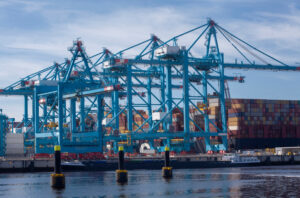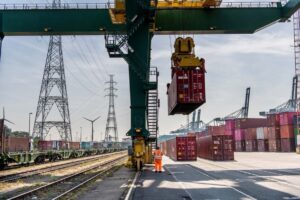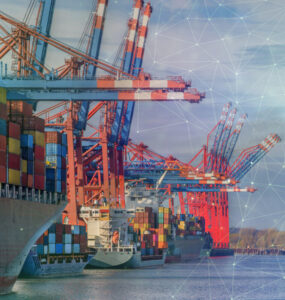CargoX is going to use blockchain to make shipping processes more efficient by digitizing Bill of Lading (B/L), one of the most important documents in the shipping process.
It aims to disrupt the global logistics industry by using blockchain to introduce smart B/L and eliminate paper versions of the legal document between the shipper and carrier which detail the goods a ship is carrying.
The company, a spin-off from an existing container booking platform business 45HC, which has an office in Hong Kong, but is based in Ljubljana, Slovenia, has already started raising money.
It reached a target of US$ 7 million through an ICO on January 23, 2018, with the initial coin offering (ICO) — an unregulated means by which a company raises funds for a new cryptocurrency — lasting 7 minutes and 40 seconds.
This is an impressive feat, but what is the company hoping to solve through its blockchain solution?
PTI Editor Laurence Doe spoke to Stefan Kukman, Founder and CEO of CargoX, to find out more.
Kukman (pictured below) is the CEO and entrepreneur at 45HC.com, who describes himself as a growth-oriented and highly focused CEO with a strong background in leading teams, product promotion and market research.
He used to work for Kuehne-Nagel, one of the biggest logistics providers.
What is CargoX’s aim?
“We are hoping to solve the three major pains of the current archaic Bill of Lading: the Smart B/L will be much faster to deliver, there will be less cost associated with it, and there will be much less chance to have it stolen or lost.
We are now on our way to deliver the product, build strong partnerships and start marketing activities to provide blockchain-based Smart Bill of Lading, and later on a Smart Letter of Credit as well.
We are also working on transforming our website, to equip it with detailed descriptions of our products.
This will be available in the coming weeks.”
CargoX wants to transform one of the most important documents in logistics:
How could Cargo X transform the way B/L documents are currently processed?
“It is quite simple, there will be no couriers involved, and there will be no need to send multiple copies.
Blockchain will encrypt the uploaded document and transfer it securely and quickly to the next receiving party in the process.
That transfer will not take days, but could take just a couple of minutes.
It will be encrypted in a way that nobody else except the involved parties can read it, and it will be delivered to the exactly addresses needed.
The system will also identify the parties involved, and only they will be able to process the document.
There will be much less cost.”
Are you in talks with any other organisations such as ports or carriers about collaborating? Is there a collaboration happening now?
“Yes, a strong community and partnerships are key for our success, therefore, parallel to our product development, we are also developing new partnerships – they will be announced soon.
Collaborations are going to take place at various levels, but we cannot disclose details yet, as we need all the details confirmed from both sides.
Nevertheless – we want to stress out that there is a lot of interest in our product.”
What cryptocurrency is CargoX using for service payments?
“We have established our own currency – the CXO token.
It is an ERC20 Ethereum-based utility token that will form a core part of our digitalised business model.
It will allow partners to interact with smart B/L dApp.
The tokens will be used for sending, archiving, changing ownership and also as payment solution for logistic services offered by selected logistic partners.
ERC20 is a common list of rules that any token based on Ethereum has to implement.”
What are the next steps you will be taking in order to launch the platform?
“At the end of Q1 2018, we plan to release the B/L exchange protocol and announce the first beta trial Smart B/L sea-freight shipment.
In Q2 of 2018, the distributed application Smart B/L dApp will be available, which will handle the blockchain-based bills of lading.
We have already signed an NVOCC [Non Vessel Owning Common Carrier — a person or company that organizes shipments for individuals or corporations] for the test trial!
The Smart B/L will be issued in Asia for a container shipment from asia to Europe.
Then we will on-board our first customers in Q2 to Q4, which will include NVOCCs, importers and exporters.
In Q1 2019, we will continue development with the banks and insurance companies to provide the Letter of Credit equivalent solutions, insurance agreements.
We plan to employ our CXO tokens as a settlement instrument by the end of 2019.
A B/L exchange protocol upgrade will allow on-chain settlement.
First, this will be possible by using our CXO tokens, but later we will also enable settlement with stable tokenised currencies.”
Why did you decide to target the shipping sector with your solution?
“We have a lot of experience in this field, and have seen the opportunity to offer a simpler, safer way to handle the very important documentation, which is currently still being treated in a way that makes possible theft, loss, and is associated with high cost and long delivery time.
We think that the shipping industry deserves better, faster, more cost sensitive ways to handle these documents.”
Is the volatility of cryptocurrency prices a concern?
“Volatility is not a concern, as the price in CXO will be pledged against US$.”
What do you think of Maersk and IBM’s entrance into the blockchain market? Do you hope to work with carriers and ports?
“IBM and Maersk are working on a solution for Maersk.
What we do differently from IBM and Maersk is that we are working on a solution for mass adoption with freight forwarders.
In addition, they are trying to add other parties within the loop such as customs.
This is perhaps fine for Europe, but impossible in the short term for Russia, Brazil or other countries, which have a slightly more complicated procedural structure.
We are also aware of others entering into blockchain, but these are all very big projects and companies.
Our approach is very different from theirs – gradual and laser-focused.
We foresee that we will be the first on the market, and we are the only one with an open ecosystem, so we expect wide and fast adoption.
Ports and carriers are not in our focus; however, if requested, we can work with them as well.”













